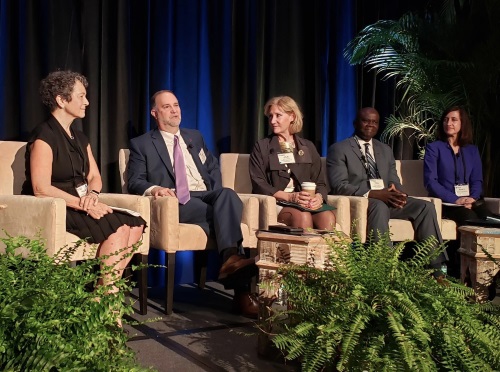Leveraging innovation and technology isn’t always about improving the physical parts of transportation infrastructure. In many ways, state departments of transportation can leverage technology – especially in terms of public outreach – to improve connections with disadvantaged businesses and communities.
[Above left to right: Yassmin Gramian, Tony Kratofil, and Amy Scarton.]
That was the message shared by three state DOT executives during a knowledge session at the 2021 virtual American Association of State Highway and Transportation Officials Washington Briefing.

“For many of us, our missions are evolving,” explained Amy Scarton, deputy secretary of the Washington State Department of Transportation. “While we remain stewards of all modes of transportation we are now acknowledging work needs to be done in terms of equity, diversity, and inclusion – and state DOTs are maturing their missions to incorporate them.”
She said that WSDOT has made equity, diversity, inclusion, and workforce development part of the agency’s focus over the last five years. “We look at where inclusion and workforce development goals intersect and see that there is great opportunity out there especially for the progress for our agencies,” Scarton noted.
While mentorship programs are not new – especially where WSDOT’s disadvantaged business enterprise or DBE program is concerned – she said the agency is “looking to refresh them” by tapping into “best practices” from around the country.
That includes helping DBE contractors not just navigate transportation work itself but learn other administrative skills necessary to manage a successful business.
“Over the last four years we’ve helped 86 firms through our mentorship program and we’re working hard to make sure the [COVID-19] pandemic does not slow us down,” Scarton noted. “Crisis can trigger change but also reveal character. That’s why we continue to engage with our communities at a pace not done before.”

Yassmin Gramian, secretary of the Pennsylvania Department of Transportation, added that this “mentoring” process includes helping DBEs keep up with technological developments in the transportation-contracting field.
For example, she noted her agency is transitioning from a “2D” model to a “3D digital model” for its project delivery process – a move expected to improve quality and cost savings. “We’ve developed a five-year strategic plan to achieve this initiative, which will create high quality data-rich models of our projects,” Gramian said. “It will also allow us to capture asset information over the life of the project from inspection and other activities related to highway administration.”
However, she is focused on ensuring that all of PennDOT’s contractors – large and small alike – are “comfortable” with this new digital delivery system. “We are very cognizant of the fact that as we move into the next phase of our digital transformation that we bring everyone along with us,” Gramian said.
“For those contractors without the tools as of yet, we put something aside for them until they are ready,” she added. “And we’re helping the smaller firms to get on the program as soon as they can – this is the biggest challenge of this program I am concerned with.”

That, explained Tony Kratofil – COO and chief engineer for the Michigan Department of Transportation – is all about “going beyond materials and technologies when we talk about innovation and [using it] to address our current business models and practices.”
He said that when it comes to the infrastructure state DOTs build, “we must offer equitable share to the communities and businesses of color it affects. We need to create a ‘safe’ platform or venue for all stakeholders to discuss transportation issues, because much of the discontent around transportation projects stems from not understanding other points of view.”
Echoing PennDOT’s Gramian, he said many DBEs find it very hard to adopt new technology due to its expense and training requirements.
“We’re able to solve some of that by extending licenses for software to DBEs and provide real-time training to them,” he said.
“DBEs don’t always have those resources. It is also about helping businesses understand the financial side of running a business,” Kratofil added. “It is about figuring out how to bring everyone along so that the DBEs don’t get left in the dust and only the big contractors remain. That is one of the big questions about equity and inclusion when it comes to transportation project work.”



